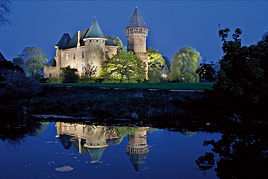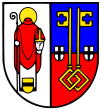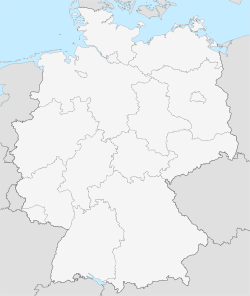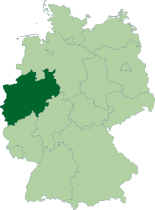Krefeld
| Krefeld | |
 |
|
| Coat of arms | Location |
 |
 |
| Administration | |
| Country | Germany |
|---|---|
| State | North Rhine-Westphalia |
| Admin. region | Düsseldorf |
| District | Urban district |
| Lord Mayor | Gregor Kathstede (CDU) |
| Basic statistics | |
| Area | 137.68 km² (53.2 sq mi) |
| Elevation | 39 m (128 ft) |
| Population | 238,031 (27/10/2009)[1] |
| - Density | 1,729 /km² (4,478 /sq mi) |
| Other information | |
| Time zone | CET/CEST (UTC+1/+2) |
| Licence plate | KR |
| Postal codes | 47701-47839 |
| Area code | 02151 |
| Website | www.krefeld.de |
Krefeld (IPA: [ˈkʁeːfɛlt]), also known as Crefeld until 1929, is a city in North Rhine-Westphalia, Germany. It is located southwest of the Ruhr area, its center just a few kilometres to the west of the River Rhine; the borough of Uerdingen is situated directly on the Rhine. Krefeld is accessed by the autobahns A57 (Cologne - Nijmegen) and the A44 (Aachen - Düsseldorf - Dortmund - Kassel)
Krefeld is also called the "Velvet and Silk City".
In more recent decades the city has hosted an honors program in foreign language (German) studies. The program annually places thirty specially selected high school students with families in and around Krefeld for intensive German language training.[2]
Krefeld's residents speak Hochdeutsch, the standard German which all educated Germans are taught. However, the native dialect is a Low German variety, sometimes locally called "Krefelder Plattdeutsch," "Krieewelsch Platt," "Plattdeutsch,," or sometimes simply "Platt." The Uerdingen line isogloss, separating general dialectical areas in Germany and neighboring Germanic-speaking countries, runs through and is named for Krefeld's Uerdingen district, originally an independent municipality.[3]
Contents |
History
The origins of the town were in Roman times, when the legions founded the military camp of Gelduba (today the borough of Gellep). Krefeld itself was first mentioned in 1105 under the name of Krinvelde. Uerdingen was originally an independent town east of Krefeld, founded in 1255. In medieval times it was larger and more important than Krefeld.
The growth of the town began in the 17th century, when Krefeld was one of few towns spared the horrors of the Thirty Years' War. Because the town was quickly overpopulated, in 1683 a group of thirteen families (Mennonites) left Krefeld, crossed the Atlantic and founded the settlement of Germantown (now incorporated in Philadelphia). The town of Uerdingen was less fortunate; it was completely destroyed in the Thirty Years' War by troops from Hesse and almost ceased to exist.
After the 1702 death of William III of Orange, Krefeld passed to the Kingdom of Prussia. The Battle of Krefeld occurred nearby in 1758 during the Seven Years' War. Krefeld and Uerdingen were included within the Prussian Province of Jülich-Cleves-Berg in 1815 (after 1822 the Rhine Province. In 1872 Krefeld became an independent city within Rhenish Prussia. In 1929 Krefeld and Uerdingen merged to form Krefeld-Uerdingen; in 1940 the name was shortened to simply Krefeld. The town became part of the new state of North Rhine-Westphalia after World War II.
Districts
There are a number of districts in Krefeld. Each has a municipal representative, with representatives chosen by local elections. The districts are:
- Stadtmitte
- Kempener Feld/Baackeshof
- Inrath/Kliedbruch
- Cracau
- Dießem/Lehmheide
- Benrad-Süd
- Forstwald
- Benrad-Nord
- Hüls
- Traar, pop: about 5,000, postal code: 47802
- Verberg
- Gartenstadt
- Bockum, pop: about 28,000, elevation: 35 m, postal code: 47800 (old: 4150 Krefeld 1)
- Linn
-
- Linn, with its own history reaching to between 1090 and 1120, was situated on the banks of the Rhine. There is in Linn a park built around a Wasserburg, a castle built at the water's edge, and with a water-filled moat. The Burg Linn, as the castle is known, has been preserved for the city's residents as a park and museum. [4][5][6]
- Gellep-Stratum
- Oppum
- Fischeln
- Königshof
- Uerdingen, pop: about 25,000, elevation: 31 m, postal code: 47829
Annexations
Here are the old cities and places that were incorporated into Krefeld:
- 1901: Linn (Stadtrecht since 1314)
- 1907: Bockum, Verberg und Oppum (all mayoralty Bockum)
- 1929:
- Krefeld became an independent city
- Uerdingen, Krefeld (received municipal law in 1255/1344, added Hohenbudberg in today's Duisburg district Friemersheim)
- Fischeln, Krefeld district
- Traar, Krefeld district
- Gellep and Stratum (in Lank), Krefeld district
- Forstwald (Vorst), Krefeld district
- Benrad und Hülserberg (Hüls), Kempem
- 1975: Locality of Hüls from Kempen (since 1970 integrated and belonged since 1929 to the Kempen-Krefeld district; in 1936 Orbroich had been independent)
Historical population of Krefeld
|
|
¹ Census data
Mayors of Krefeld from 1848
- 1848 - 1872: Ludwig Heinrich Ondereyck
- 1872 - 1881: Friedrich Christian Roos
- 1882 - 1903: Ernst Küper
- 1903 - 1905: Dr. Wilhelm Hammerschmidt
- 1905 - 1911: Dr. Adalbert Oehler
- 1911 - 1930: Dr. Johannes Johansen
- 1945 - 1946: Dr. Johannes Stepkes
- 1946 - 1947: Dr. Wilhelm Warsch
- 1947 - 1949: Hermann Passen
- 1949 - 1951: Hanns Müller (FDP)
- 1951 - 1956: Johannes Hauser (CDU)
- 1956 - 1961: Josef Hellenbrock (SPD)
- 1961 - 1968: Herbert van Hüllen (CDU)
- 1968 - 1982: Hansheinz Hauser (CDU)
- 1982 - 1989: Dieter Pützhofen, first term in office (CDU)
- 1989 - 1994: Willi Wahl (SPD)
- 1994 - 2004: Dieter Pützhofen, second term in office (CDU)
- 2004 - present: Gregor Kathstede (CDU)
City counsellors 1946 until 1999
- 1946 - 1949: Dr. Johan Stepkes
- 1949 - 1964: Dr. Bernhard Heun
- 1964 - 1986: Dr. Hermann Steffens
- 1986 - 1988: Dr. Alfred Dahlmann
- 1988 - 1999: Heinz-Josef Vogt
Transport
Krefeld is connected to the Deutsche Bahn network with several stations, however they all carry local trains only. The Düsseldorf-based Rheinbahn operates a Stadtbahn service to the centrally located Rheinstraße stop. This line was the first electric inter-city rail line in Europe, established in 1898, and commonly called the K-Bahn because of the letter "K" used to denote the trains to Krefeld. Nowadays, in the VRR notation it is called U76, with the morning express trains numbered as U70, the line number there being of a red colour instead of the usual blue used for U-Bahn lines. The term 'K-Bahn', however, prevails in common usage.
The city of Krefeld itself operates four tramway and several bus lines under the umbrella of SWK Mobil, a city-owned company. The tram network, however, has fallen into disrepair as the newest rolling stock has already passed 25 years of age and is not at all friendly towards handicapped passengers. The tramway's future is presently being discussed.
Twinnings
|
|
Notable Natives
Scientists:
- Rudi Dornbusch (December 1, June 8, 1942 - July 25, 2002, German economist
- Max Zorn (June 6, 1906 - March 9, 1993 in Bloomington, Indiana), German mathematician
Writers, poets and journalists:
- Kurt Feltz (April 14, 1910 - August 3, 1982 in Majorca) - poet
- Werner Ross (1912 in Uerdingen - 2002), German writer
- Otto Brües (May 1, 1897 - April 18, 1967) - a journalist
Musicians:
- Blind Guardian, popular German heavy metal band
- Ralf Hütter (August 20, 1946), Lead Singer of Electronic Music Pioneers Kraftwerk
- Aquagen, popular German trance and techno artists
- Heinrich Band (1821 - 1860)
Artists:
- Joseph Beuys (May 12, 1921 - 1986), German artist
- Heinrich Campendonk (November 3, 1889 - May 9, 1957 in Amsterdam)
- Albert Oehlen, German artist
- Markus Oehlen, German artist
Aviators:
- Felix Kracht (1912-2002), aerospace engineer, an Airbus pioneer and former Senior Vice President
- Werner Voss (April 13, 1897 - September 23, 1917), German WW1 aviator
Sportspeople:
- Martin Hyun, German and U.S. hockey player
References
External links
- Official city website
- http://www.flachsmarkt.de/ - Krefeld-Linner Flachsmarkt
- http://www.krefeld-pinguine.de/ - Krefeld Icehockeyteam
- http://www.kfc-online.de/ - Krefeld Soccerteam
- http://www.theater-krefeld.de/ - Stadttheater Krefeld
- http://www.phenomer.com/ - Krefelds Serious Friend Network
- http://www.Krefeldtreffpunkt.de/ - Krefelds Veranstaltungen, Events,Termine
|
||||||||||
